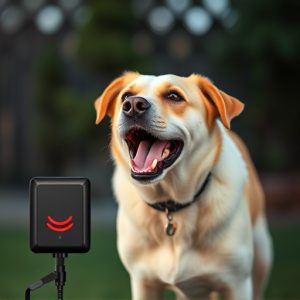Ultrasonic Systems: Effective Dog Repellent with Optimal Vibration Settings
Dogs' behaviors can be modified using ultrasonic dog repellent devices (25-40 kHz) as a non-inv…….
Dogs' behaviors can be modified using ultrasonic dog repellent devices (25-40 kHz) as a non-invasive solution for issues like barking or aggression. These devices emit inaudible high-frequency sound waves that irritate dogs due to their sensitive hearing. The best vibration settings vary based on factors like dog size, breed, and environment. Starting with low settings and gradually increasing ensures effectiveness without causing stress. While effective, not all dogs react similarly, and some breeds may experience discomfort from the high-pitched tones. Training requires identifying triggers and behaviors, starting with lower settings, consistent sessions, positive reinforcement, and regular progress reviews to achieve comfortable behavior modification alongside your dog's well-being and safety.
Unleash the power of behavior modification with canine-focused ultrasonic systems. This comprehensive guide explores innovative solutions to common dog behaviors, delving into the science behind ultrasonic repellents and their impact on training. We uncover the secrets to selecting the best vibration settings for maximum effectiveness, while balancing advantages and potential drawbacks. Armed with expert tips on implementation and training, transform your canine companion’s behavior effortlessly.
- Understanding Canine Behavior and Ultrasonic Systems
- How Ultrasonic Devices Repel Dogs: Science Behind It
- Choosing the Best Vibration Settings for Maximum Effectiveness
- Advantages and Potential Drawbacks of Using Dog Repellent Devices
- Training and Implementation Tips for Successful Behavior Modification
Understanding Canine Behavior and Ultrasonic Systems
Dogs, much like humans, have distinct behaviors that can be influenced by their environment and experiences. Understanding canine behavior involves recognizing their natural instincts, such as territoriality, hunting, and social interaction. By comprehending these behaviors, we can better address issues like excessive barking, jumping, or aggression, which often stem from stress, anxiety, or lack of stimulation.
Ultrasonic systems have emerged as a popular tool in canine behavior modification, particularly for training and deterring unwanted actions. These devices emit high-frequency sound waves that are inaudible to humans but can be detected by dogs. The best vibration settings on these dog repellent devices are those that are within the effective range (typically 25-40 kHz) and tailored to the specific behavior being addressed. By combining ultrasonic technology with positive reinforcement training, pet owners can create a more harmonious living environment while ensuring their canine companions remain safe and well-behaved.
How Ultrasonic Devices Repel Dogs: Science Behind It
Ultrasonic devices operate by emitting high-frequency sound waves that are inaudible to humans but irritating to dogs. These sounds, typically ranging from 25 to 64 kHz, target a dog’s sensitive hearing and can be adjusted for optimal effectiveness. The best vibration settings on these devices vary based on the size, breed, and temperament of the dog, as well as the environment in which they are used.
The science behind their effectiveness lies in the dog’s natural aversion to the sound. Unlike humans, dogs have a more sensitive hearing range, making them receptive to ultrasonic frequencies. When a dog encounters one of these devices, the high-frequency sound disrupts their balance and causes discomfort, prompting them to leave the area. This behavior modification technique is non-confrontational and humane, offering a safe alternative to traditional training methods that rely on punishment.
Choosing the Best Vibration Settings for Maximum Effectiveness
When utilizing a canine behavior modification ultrasonic system, selecting the optimal vibration settings is paramount for achieving maximum effectiveness as a dog repellent device. Different dogs may react differently to varying frequencies and intensities, so finding the sweet spot requires some adjustments and observation. Start with the lowest setting, allowing your dog to get accustomed to the sound while monitoring their reaction. Gradually increase the vibration level until you find a point where your dog shows signs of discomfort or distraction without becoming overly stressed.
This process involves paying close attention to your dog’s behavior. If they appear undisturbed or even seemingly unbothered, it might not be effective enough. Conversely, if they display excessive anxiety or aggression, the setting is too high and should be reduced. The best vibration settings will prompt your dog to avoid the area without causing undue distress, striking a balance between deterrence and well-being.
Advantages and Potential Drawbacks of Using Dog Repellent Devices
Using dog repellent devices, particularly those that employ ultrasonic technology, offers several advantages for behavior modification. These devices emit high-frequency sound waves that are inaudible to humans but can deter dogs from unwanted behaviors like barking or chewing. One of the key benefits is their non-invasive and humane nature; they don’t cause physical harm or pain, unlike traditional shock collars. Additionally, ultrasonic systems can be highly effective with consistent usage, offering a gentle yet powerful tool for training.
However, potential drawbacks exist. Not all dogs react to ultrasonic devices in the same way, and finding the best vibration settings might require time and patience. Some dogs may even become accustomed to the sound, rendering the device less effective over time. Moreover, these devices may not be suitable for all situations or dog breeds; certain breeds with heightened hearing sensitivity could experience discomfort from the high-pitched tones. Always consider the specific needs and characteristics of your dog before introducing such a modification system.
Training and Implementation Tips for Successful Behavior Modification
Training and implementing a canine behavior modification ultrasonic system requires careful consideration for optimal results. Firstly, understand your dog’s triggers – what specific behaviors are you aiming to change? Different dogs may react to different frequencies, so finding the best vibration settings tailored to your pet is crucial. The best vibration settings can vary based on individual preferences and sensitivity, so start with a lower setting and gradually increase until you find the most effective yet comfortable level for your dog.
Consistency is key in behavior modification. Establish a routine and schedule for training sessions, ensuring they’re short, frequent, and positive. Reward good behavior immediately using treats or praise to reinforce desired actions. Always use the ultrasonic device as a supplementary tool alongside positive reinforcement techniques, never as punishment. Regularly review your dog’s progress and adjust settings or training methods as needed to ensure continuous improvement in their behavior.
Canine behavior modification through ultrasonic systems offers a humane and effective approach to addressing unwanted behaviors. By understanding canine behavior and leveraging the science behind ultrasonic devices, pet owners can harness the power of sound waves to repel dogs non-invasively. Choosing the optimal vibration settings is key to maximizing effectiveness, balancing advantages like distance control and minimal disturbance with potential drawbacks such as selective sensitivity. Successful implementation requires thoughtful training strategies and consistent use, ultimately fostering a more harmonious relationship between pets and their environments. To ensure positive outcomes, consider the best vibration settings for your dog repellent device and incorporate these tips into your behavior modification journey.


